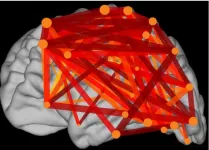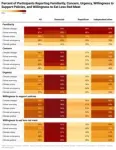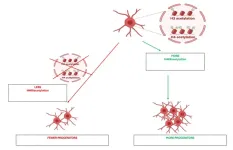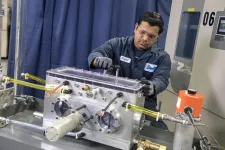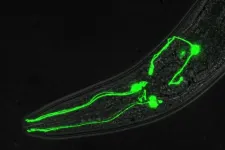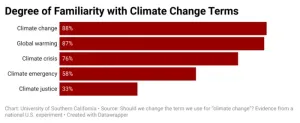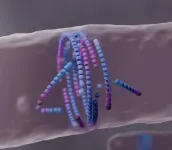(Press-News.org) For decades, scientists have focused on how the brain processes information in a hierarchical manner, with different brain areas specialized for different tasks. However, how these areas communicate and integrate information to form a coherent whole has remained a mystery. Now, researchers at University of California San Diego School of Medicine have brought us closer to solving it by observing how neurons synchronize across the human brain while reading. The findings are published in Nature Human Behavior and are also the basis of a thesis by UC San Diego School of Medicine doctoral candidate Jacob Garrett.
“How the activity of the brain relates to the subjective experience of consciousness is one of the fundamental unanswered questions in modern neuroscience,” said study senior author Eric Halgren, Ph.D., professor in the Departments of Neurosciences and Radiology at UC San Diego School of Medicine. “If you think about what happens when you read text, something in the brain has to turn that series of lines into a word and then associate it with an idea or an object. Our findings support the theory that this is accomplished by many different areas of the brain activating in sync.”
This synchronization of different brain areas, called “co-rippling” is thought to be essential for binding different pieces of information together to form a coherent whole. In rodents, co-rippling has been observed in the hippocampus, the part of the brain that encodes memories. In humans, Halgren and his colleagues previously observed that co-rippling also occurs across the entire cerebral cortex.
To examine co-rippling at the mechanistic level, Ilya Verzhbinsky, an M.D./Ph.D. candidate in UC San Diego School of Medicine’s Medical Scientist Training Program completing his research in Halgren’s lab, led a study published in the Proceedings of the National Academy of Sciences that looked at what happens to single neurons firing in different cortical areas during ripples. The present study looks at the phenomenon with a wider lens, asking how the many billions of neurons in the cortex are able to coordinate this firing to process information.
“There are 16 billion neurons in the cortex – double the number of people on Earth,” said Halgren. “In the same way a large chorus needs to be organized to sound as a single entity, our brain neurons need to be coordinated to produce a single thought or action. Co-rippling is like neurons singing on pitch and in rhythm, allowing us to integrate information and make sense of the world. Unless they’re co-rippling, these neurons have virtually no effect on the other, but once ripples are present about two thirds of neuron pairs in the cortex become synchronized. We were surprised by how powerful the effect was.”
Co-rippling in the cortex has been difficult to observe in humans due to limitations of noninvasive brain scanning. To work around this problem, the researchers used an approach called intracranial electroencephalography (EEG) scanning, which measures the electrical activity of the brain from inside the skull. The team studied a group of 13 patients with drug-resistant epilepsy who were already undergoing EEG monitoring as part of their care. This provided an opportunity to study the activity of the brain in more depth than typical brain scans using noninvasive approaches.
Participants were shown a series of animal names interspersed with strings of random consonants or nonsense fonts and then asked to press a button to indicate the animal whose name they saw. The researchers observed three stages of cognition during these tests: an initial hierarchical phase in visual areas of the cortex in which the participant could see the word without conscious understanding of it; a second stage in which this information was “seeded” with co-ripples into other areas of the cortex involved in more complex cognitive functions; and a final phase, again with co-ripples, where the information across the cortex is integrated into conscious knowledge and a behavioral response – pressing the button.
The researchers found that throughout the exercise, co-rippling occurred between the various parts of the brain engaged in these cognitive stages, but the rippling was stronger when the participants were reading real words.
The study's findings have potential long-term implications for the treatment of neurological and psychiatric disorders, such as schizophrenia, which are characterized by disruptions in these information integration processes.
"It will be easier to find ways to reintegrate the mind in people with these disorders if we can better understand how minds are integrated in typical, healthy cases,” added Halgren.
More broadly, the study's findings have significant implications for our understanding of the link between brain function and human experience.
"This is a fundamental question of human existence and gets at the heart of the relationship between mind and brain,” said Halgren. “By understanding how our brain's neurons work together, we can gain new insights into the nature of consciousness itself."
Additional co-authors on the study include Erik Kaestner at UC San Diego School of Medicine, Chad Carlson at Medical College of Wisconsin, Werner K. Doyle and Orrin Devinsky at New York University Langone School of Medicine, and Thomas Thesen at Geisel School of Medicine.
The study was funded, in part, by National Institutes of Health (grants MH117155, T32MH020002) and the Office of Naval Research (grant N00014-16-1-2829).
# # #
END
State-of-the-art brain recordings reveal how neurons resonate
Findings shed light on how the human brain turns words into thoughts
2024-08-12
ELSE PRESS RELEASES FROM THIS DATE:
New study reveals unique histone tag in adult oligodendrocyte progenitor cells, opening doors for advanced myelin repair therapies
2024-08-12
NEW YORK, August 12, 2024 — In a groundbreaking study, researchers with the Advanced Science Research Center at the CUNY Graduate Center (CUNY ASRC) have identified a distinct histone tag in adult oligodendrocyte progenitor cells (OPCs) that may pave the way for innovative therapies targeting myelin repair, a critical target for several neurodegenerative and psychiatric disorders, including multiple sclerosis, Alzheimer’s disease, and schizophrenia. The histone tag, characterized by lysine 8 acetylation on histone H4, identifies a significant departure from the histone modifications found in neonatal OPCs.
Detailed in a ...
SwRI launches Electrified Vehicle and Energy Storage Evaluation-II battery consortium
2024-08-12
SAN ANTONIO — August 12, 2024 – Southwest Research Institute (SwRI) is launching the next phase of an electric vehicle (EV) battery consortium dedicated to understanding performance of energy storage systems. The Electrified Vehicle and Energy Storage Evaluation-II (EVESE-II) consortium builds on more than a decade of SwRI-led, precompetitive research with companies across the mobility sector.
“We are proud to serve the EV industry by bringing together manufacturers, suppliers and battery designers and developers with materials scientists to address a variety of challenges,” said Dr. Andre Swarts, an SwRI staff engineer ...
Possible explanation for link between diabetes and Alzheimer's
2024-08-12
People with type 2 diabetes are at increased risk of Alzheimer's disease and other cognitive problems. A new study led by Umeå University, Sweden, shows that the reason may be that people with type 2 diabetes have more difficulty getting rid of a protein that may cause the disease.
"The results may be important for further research into possible treatments to counteract the risk of people with type 2 diabetes being affected by Alzheimer's," says Olov Rolandsson, senior professor at the Department of Public Health and Clinical Medicine at Umeå University, research leader and first author of the study.
The substances ...
Surf spots are global ally in climate fight, study finds
2024-08-12
Surf Spots are Global Ally in Climate Fight, Study Finds
Nearly 90 million metric tonnes of planet-warming carbon found surrounding surf breaks across the world; U.S., Australia, Indonesia, Brazil identified as conservation priorities
ARLINGTON, Va. (Aug. 12, 2024) – A first-of-its-kind study, published today in Conservation Science and Practice, has found that the forests, mangroves and marshes surrounding surf breaks store almost 90 Mt (million metric tonnes) of climate-stabilizing “irrecoverable carbon,” making these coastal locations ...
Taking a ‘one in a million’ shot to tackle dopamine-linked brain disorders
2024-08-12
Dopamine, a powerful brain chemical and neurotransmitter, is a key regulator of many important functions such as attention, experiencing pleasure and reward, and coordinating movement. The brain tightly regulates the production, release, inactivation and signaling of dopamine via a host of genes whose identity and link to human disease continue to expand.
Brain disorders associated with altered dopamine signaling include substance use disorder, attention deficit hyperactivity disorder (ADHD), autism, bipolar disorder, schizophrenia and Parkinson’s disease. The complexity of the human brain and its ...
Just say “climate change” – not “climate emergency”
2024-08-12
The terms “climate change” and “global warming” are not only more familiar to people than some of their most common synonyms, but they also generate more concern about the warming of the Earth, according to a USC study published today in the journal Climatic Change.
The study began by looking at how familiar people are with the terms “global warming,” “climate change,” “climate crisis,” “climate emergency,” and “climate justice.” ...
Mature forests vital in frontline fight against climate change
2024-08-12
Mature forests have a key role to play in the fight against climate change – extracting carbon dioxide (CO2) from the atmosphere and locking it into new wood, a new study reveals.
Researchers discovered that older trees responded to increased atmospheric levels of CO2 by increasing production of woody biomass – countering existing theories that mature woodland has no capacity to respond to elevated CO2 levels.
The experts found exposure to elevated levels of the greenhouse gas (ambient ...
Balancing technology and governance are key to achieving climate goals
2024-08-12
Despite advancements in clean energy, global CO2 emissions continue to rise. IIASA researchers contributed to a new international study that underscores the importance of integrating technological advancements with robust institutional capacities to formulate effective climate policies.
The Paris Agreement's goal to limit global warming to 1.5°C demands rapid reductions in CO2 emissions and heightened attention to non-CO2 greenhouse gases. Despite advancements in clean energy, global CO2 ...
Align or die
2024-08-12
A previously unknown mechanism of active matter self-organization essential for bacterial cell division follows the motto ‘dying to align’: Misaligned filaments ‘die’ spontaneously to form a ring structure at the center of the dividing cell. The study, led by the Šarić group at the Institute of Science and Technology Austria (ISTA), was published in Nature Physics. The work could find applications in developing synthetic self-healing materials.
How does matter, lifeless by definition, self-organize and make us alive? One of the hallmarks of life, self-organization, is the spontaneous formation ...
Breakthrough heart MRI technique accurately predicts heart failure risk in general population
2024-08-12
New research looking at more than 39,000 UK biobank participants found those with higher heart pressure estimated by Magnetic Resonance Imaging (MRI) were five times more likely to develop heart failure
Key risk factors discovered for increased heart pressure include age over 70, high blood pressure, obesity, alcohol consumption and male gender
Breakthrough by University of East Anglia and Queen Mary University of London suggests that heart MRI could potentially replace invasive diagnostic tests
Peer-reviewed – Observational Study - People
MRI scans could replace invasive heart tests, as new research shows they can reliably estimate pressures ...
LAST 30 PRESS RELEASES:
Tracing the quick synthesis of an industrially important catalyst
New software sheds light on cancer’s hidden genetic networks
UT Health San Antonio awarded $3 million in CPRIT grants to bolster cancer research and prevention efforts in South Texas
Third symposium spotlights global challenge of new contaminants in China’s fight against pollution
From straw to soil harmony: International team reveals how biochar supercharges carbon-smart farming
Myeloma: How AI is redrawing the map of cancer care
Manhattan E. Charurat, Ph.D., MHS invested as the Homer and Martha Gudelsky Distinguished Professor in Medicine at the University of Maryland School of Medicine
Insilico Medicine’s Pharma.AI Q4 Winter Launch Recap: Revolutionizing drug discovery with cutting-edge AI innovations, accelerating the path to pharmaceutical superintelligence
Nanoplastics have diet-dependent impacts on digestive system health
Brain neuron death occurs throughout life and increases with age, a natural human protein drug may halt neuron death in Alzheimer’s disease
SPIE and CLP announce the recipients of the 2025 Advanced Photonics Young Innovator Award
Lessons from the Caldor Fire’s Christmas Valley ‘Miracle’
Ant societies rose by trading individual protection for collective power
Research reveals how ancient viral DNA shapes early embryonic development
A molecular gatekeeper that controls protein synthesis
New ‘cloaking device’ concept to shield sensitive tech from magnetic fields
Researchers show impact of mountain building and climate change on alpine biodiversity
Study models the transition from Neanderthals to modern humans in Europe
University of Phoenix College of Doctoral Studies releases white paper on AI-driven skilling to reduce burnout and restore worker autonomy
AIs fail at the game of visual “telephone”
The levers for a sustainable food system
Potential changes in US homelessness by ending federal support for housing first programs
Vulnerability of large language models to prompt injection when providing medical advice
Researchers develop new system for high-energy-density, long-life, multi-electron transfer bromine-based flow batteries
Ending federal support for housing first programs could increase U.S. homelessness by 5% in one year, new JAMA study finds
New research uncovers molecular ‘safety switch’ shielding cancers from immune attack
Bacteria resisting viral infection can still sink carbon to ocean floor
Younger biological age may increase depression risk in older women during COVID-19
Bharat Innovates 2026 National Basecamp Showcases India’s Most Promising Deep-Tech Ventures
Here’s what determines whether your income level rises or falls
[Press-News.org] State-of-the-art brain recordings reveal how neurons resonateFindings shed light on how the human brain turns words into thoughts
